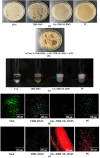Experimental research on fungal inhibition using dissolving microneedles of terbinafine hydrochloride nanoemulsion for beta-1,3-glucanase
- PMID: 40556857
- PMCID: PMC12183721
- DOI: 10.1039/d5na00163c
Experimental research on fungal inhibition using dissolving microneedles of terbinafine hydrochloride nanoemulsion for beta-1,3-glucanase
Abstract
Objective: Onychomycosis is characterized by high transmission and low recovery rates, leading to a lack of optimal treatments. This study used dissolving microneedles as drug carriers to design dual-loaded DMN patches with β-1,3-glucanase and terbinafine hydrochloride nanoemulsion. Methods: Dissolving microneedles of terbinafine hydrochloride nanoemulsion for beta-1,3-glucanase (Gls-TBH-NE-DMN) were prepared using the centrifugal molding method. Parafilm®, weight method, mouse skin puncture experiments, and mouse skin tissue sections were used to evaluate the mechanical properties of Gls-TBH-NE-DMN. Gls-TBH-NE-DMN was tested for its in vitro anti-Candida albicans susceptibility, ability to inhibit fungal cell wall synthesis, and fungal biofilm penetration and inhibition capabilities. The in vivo inhibitory effect of Gls-TBH-NE-DMN on fungi was studied using a rabbit nail infection model. Results: Gls-TBH-NE-DMN exhibited a penetration rate of 98% on skin simulants and a compressive bending resistance of 12.75%. It was nonirritating to the dorsal skin of mice, with no edema or erythema on the surface of the skin, suggesting a good safety profile. The accumulative release of Gls-TBH-NE-DMN at 72 h was 78.74% ± 0.64%, and that of terbinafine hydrochloride dissolving microneedles was 49.52% ± 0.80%. In the in vitro transdermal permeation experiment, the cumulative transdermal permeation of Gls-TBH-NE-DMN at 72 h was 73.21% ± 0.84% and that of terbinafine hydrochloride (TBH) was 20.57% ± 0.98%. In vitro inhibition of C. albicans showed that the lowest inhibitory concentration in the Gls-TBH-NE-DMN group was 512 μg mL-1. Furthermore, experiments showed that Gls-TBH-NE-DMN could effectively inhibit fungal cell wall synthesis and disrupt the C. albicans biofilm, inhibiting fungal growth. Conclusions: Gls-TBH-NE-DMN prepared in this study provides new ideas for treating skin fungal diseases and for developing antimicrobial drug formulations.
This journal is © The Royal Society of Chemistry.
Conflict of interest statement
The authors have no relevant financial or non-financial interests to disclose.
Figures





Similar articles
-
Oral antifungal medication for toenail onychomycosis.Cochrane Database Syst Rev. 2017 Jul 14;7(7):CD010031. doi: 10.1002/14651858.CD010031.pub2. Cochrane Database Syst Rev. 2017. PMID: 28707751 Free PMC article.
-
Development of a Novel Drug Delivery System "Nanoemulfoam" for Topical Delivery of Terbinafine Hydrochloride as a Repurposed Therapy in Skin Cancer: Formulation, Optimization, In Vitro Characterization, Ex Vivo Transdermal Permeability, Cytotoxicity Studies, and In Silico Assessment.Pharmaceuticals (Basel). 2025 Jun 27;18(7):972. doi: 10.3390/ph18070972. Pharmaceuticals (Basel). 2025. PMID: 40732261 Free PMC article.
-
Innovative freeze-drying technique in the fabrication of dissolving microneedle patch: Enhancing transdermal drug delivery efficiency.Drug Deliv Transl Res. 2024 Nov;14(11):3112-3127. doi: 10.1007/s13346-024-01531-y. Epub 2024 Mar 2. Drug Deliv Transl Res. 2024. PMID: 38431532
-
Novel double-layered PLGA microparticles-dissolving microneedle (MPs-DMN) system for peptide drugs sustained release by transdermal delivery.Int J Pharm. 2025 Feb 10;670:125128. doi: 10.1016/j.ijpharm.2024.125128. Epub 2024 Dec 24. Int J Pharm. 2025. PMID: 39722375
-
Systemic antifungal therapy for tinea capitis in children.Cochrane Database Syst Rev. 2016 May 12;2016(5):CD004685. doi: 10.1002/14651858.CD004685.pub3. Cochrane Database Syst Rev. 2016. PMID: 27169520 Free PMC article.
References
LinkOut - more resources
Full Text Sources
Miscellaneous

